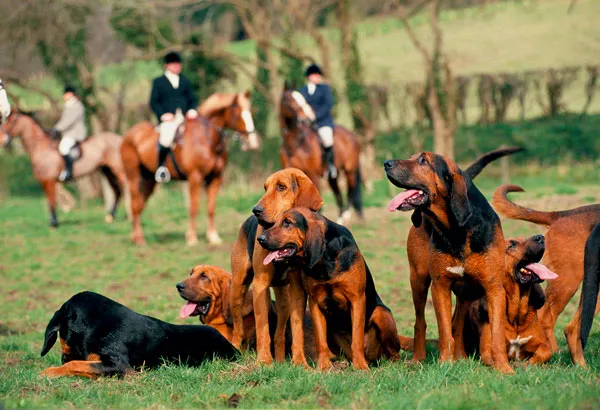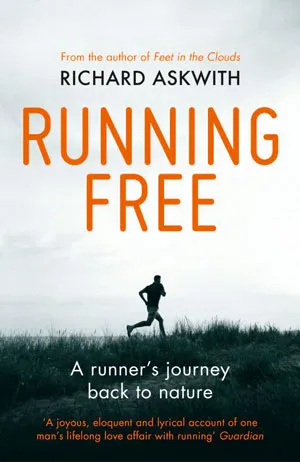It was 24 years ago. We had just moved from London to the small Northamptonshire village where we have lived ever since. It was a bright spring morning. I went for a run.
I ran, as I always did, on the roads. It had never occurred to me that there was any other way of doing it.
On an obscure back lane, a couple of miles from home, I was perplexed by a sudden gust of sound behind me.
By the time I recognised it as the panting of dogs I was surrounded: by 20 or more calf-sized, slobbering bloodhounds. They seemed thrilled to meet me and were taking it in turns to put their paws on my shoulders
and lick my face when the pack was joined by its leader: a weatherbeaten young man on a quad bike.
We talked. The hounds lived in a nearby village, he explained. He was their kennel huntsman and was escorting them home. “What do they hunt?” I asked him. “People like you,” he replied.
The quarry’s tale
So began a strange phase in my life that would transform my approach both to running and to the countryside.
Bloodhounds are different from foxhounds. They are bigger and faster, with black-and-tan colouring, soulful eyes and jowls and ears that droop like judges’ wigs. They have a better sense of smell. And, crucially, they don’t hunt foxes – they didn’t even do so when fox-hunting was legal. Instead, they hunt people; always assuming that a willing person can be found. Rural runners were rare in the 1990s, and Graham, the kennel huntsman, was quick to sign me up.
My duties were simple: to run through the fields he told me to run through, crossing fences and hedges
at points that hounds and horses could be expected to negotiate too; to reach the designated end-point before the hounds did; and to reward them when they did so with warm words and biscuits.
Sometimes I was quarry for a formal hunt, typically running three or four “lines” of four or five miles each in the course of a Sunday afternoon, with followers on horseback. More often it was just me, Graham and the hounds, honing our skills and our fitness early on weekday mornings.
Either way, there were no roads involved, and only the occasional stretch of path or track. This was running as wild creatures do it, straight through the middle of fields and woods, under hedges and over ditches, up and down hills, through mud, thistles, nettles, bogs and streams – running not past the landscape but in it.
Graham would give me a start, sadistically calculated to ensure that I only just made it in time. I would struggle through the rough ground as fast as I could, barely pausing to curse when I slipped or fell. Then,
from the end-point, I would turn and watch, fascinated, as the pack glided over the same route, confidently following my invisible footsteps.
Hunting humans
Bloodhounds don’t hunt an artificial trail (as modern foxhounds are supposed to do). Instead, they “hunt the clean boot” – that is, whatever faint traces of odour the runner naturally leaves. Seeing them do so, I began to imagine how the world must seem through a hound’s senses.
I realised how a scent lingers like a fading vapour trail just above the ground; how strong winds can displace it, damp air dilute it and frost make it resonate with thrilling clarity.
I began, too, to realise how much I had been missing out on when I ran on the tarmac between the fields instead of through them. Then, they were just views: two-dimensional patchworks of green to be admired like paintings. Now they were rich, multi-dimensional worlds with layer upon layer of constantly changing meaning. Every nuance of the landscape – the gradient, the going, the vegetation, the season – affected my experience as a runner, making running more difficult but also far more interesting. If I read the ground correctly, I could avoid hazards and pick out more forgiving lines; and the more I interacted with the landscape, the more I empathised with all the other creatures who used it. Nature had never felt so visible, or so fascinating.
Measurements of time, distance and speed became irrelevant. I no longer ran for self-improvement. Instead, I was drawn forward by delight in nature. The process of concentrating intensely on my surroundings, with all my senses, absorbed me utterly. What was the point of monitoring my performance? I already had all the motivation I needed.

Hounds at your heels
Survival instinct came into it too. No matter how many times you have heard it, the sound of a pack of hounds in full cry behind you unfailingly provokes a frisson of neck-tingling fear, causing even the most exhausted runner to break into an alarmed sprint. This did wonders for my fitness.
But fitness is temporary. Decades later, it’s the other things that I remain grateful for, long after the kennels moved to a different part of the county and my relationship with the pack came to an end. As a runner, I appreciate the confidence that acting as the bloodhounds’ quarry gave me in running over rough ground, emboldening me to run in wilder places too (such as mountains) and teaching me the long-term joys of running looking outwards rather than inwards, not driven by willpower but pulled forward by curiosity, as a dog is.
Above all, I cherish the broader, life-changing lesson that those who get most from the countryside are those who actually do something within it, rather than merely looking at it. There’s nothing wrong with enjoying
a lovely view. But you cannot really appreciate a landscape until you are totally immersed in it.
Be hunted
Richard Askwith ran with The Farmers Bloodhounds, based near Towcester in Northamptonshire. For details of future events and how to take part, see www.farmersblood hounds.co.uk or watch them in action.
Other bloodhound packs hunt human runners around the country, including East Anglia (www.eabh.co.uk), Cheshire (www.cheshirebloodhounds.co.uk) and Hampshire (www.cranwellbloodhounds.co.uk).
For more information about the sport in general, and to contact a bloodhound pack near you, see the website of the
Masters of Bloodhounds Association: www.whaleyonline.co.uk/MBHA/Index.html

Richard Askwith is associate editor of The Independent and a keen runner whose latest book Running Free: A Runner’s Journey Back to Nature (Yellow Jersey, £8.99), was short-listed for The Thwaites Wainwright Prize 2015.